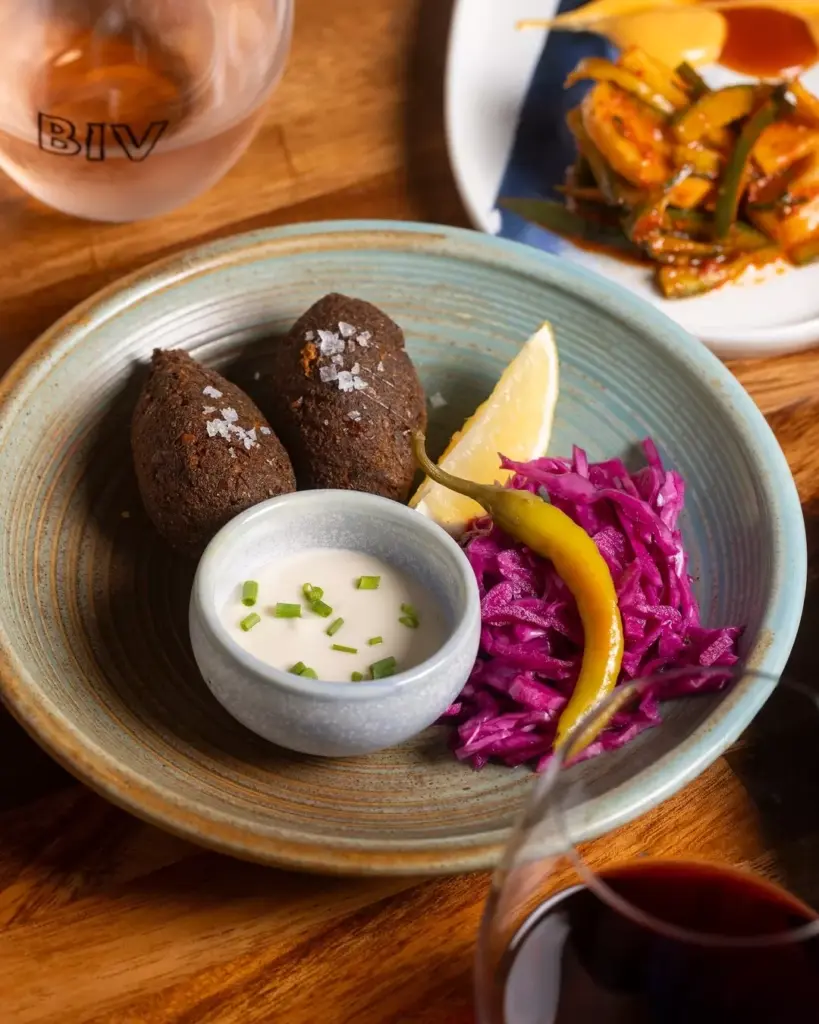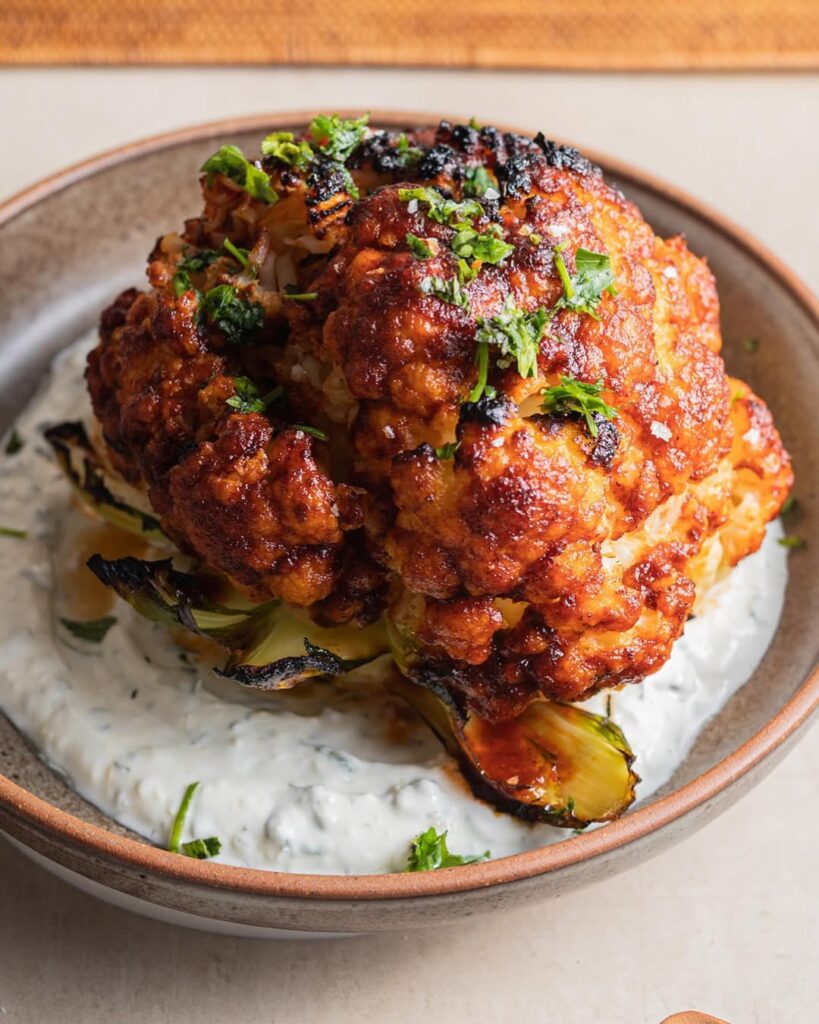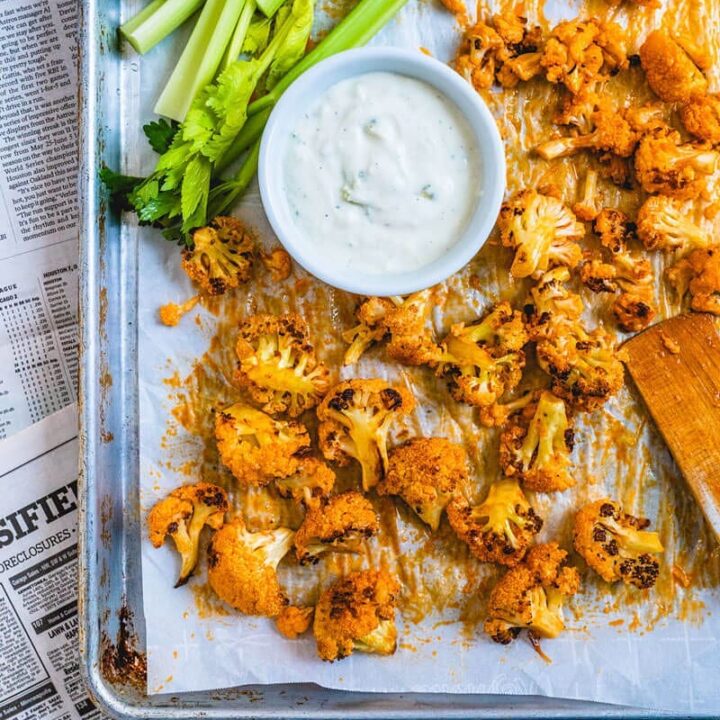If you still think cauliflower is boring, it’s because no one’s thrown it on a hot grill yet.
Once that white, humble vegetable hits open flame, it transforms – smoky, charred, caramelized, and shockingly satisfying. Add a drizzle of bright, garlicky herb tarator, and suddenly you’ve got a dish that could rival any steak.
This recipe isn’t about pretending vegetables are meat. It’s about letting cauliflower play in the big leagues – fire, smoke, and bold flavor – and giving it the spotlight it deserves.
Whether you’re serving vegetarians or just looking for something fresh to grill, these grilled cauliflower wedges are a guaranteed crowd-pleaser.

The Story Behind the Sauce
Let’s talk about herb tarator, the unsung hero of this dish. Tarator is a Mediterranean-style sauce that’s kind of like if hummus and pesto had a cool cousin.
Traditionally, it’s made with nuts, garlic, olive oil, and lemon – creamy, nutty, and fresh all at once.
In this version, we keep it simple: toasted walnuts or almonds, a big handful of herbs, and enough lemon to make the flavor pop. It’s the perfect match for the grilled cauliflower wedges – the earthy char balanced by the brightness of the sauce.
Why It Works
The magic here is contrast. You’ve got:
- Smoky char from the grill
- Creamy, garlicky tang from the tarator
- Fresh herbs and lemon tying it all together
It’s a lesson in balance. Cauliflower’s mild flavor is a blank canvas for bold moves, and grilling gives it the backbone it needs.
This isn’t your average “healthy” dish – it’s grilled, vibrant, and full of character.
Choosing the Right Cauliflower for Grilling
The first step to great grilled cauliflower wedges is picking the right head.
You want one that feels heavy for its size – dense, tight florets mean less water, which equals better char and fewer grill casualties. If it’s light or the florets look loose and airy, it’ll steam instead of sear.
Don’t be afraid to experiment with colors – orange and purple cauliflowers not only look stunning but bring subtle sweetness and extra antioxidants. When you cut it into wedges, keep the core intact so everything holds together.
And if you’re buying from a farmer’s market, ask for a fresh harvest – older cauliflower dries out fast. Remember: a solid, compact head is your ticket to perfect grill marks and that smoky caramelized flavor we’re after.
Mastering the Perfect Grill Marks
Good grill marks aren’t luck – they’re timing and confidence. Start with medium-high heat, about 400°F (200°C), and make sure your grates are clean and oiled.
Lay the cauliflower wedges flat, press gently, and then – this is key – leave them alone. Resist the urge to poke, flip, or fuss. Let the grill do its job. After about five minutes, give one a test peek.
You’re looking for that golden-brown lattice of char, not ash.
When you flip, move the wedges to a fresh spot on the grill for even searing. A light brush of oil halfway through can help build shine and keep things crisp.
It’s a little patience and a little instinct – that perfect balance between flame and flavor. And if you get a few dark edges? That’s just character.

Make It a Meal: Building a Whole Menu Around Cauliflower
Grilled cauliflower wedges deserve more than a side plate – they can headline the whole show. Build a simple Mediterranean-style menu around them: serve with lemony couscous, garlicky yogurt sauce, and warm pita.
Add a bright cucumber-tomato salad, maybe a cold glass of rosé or minty iced tea, and suddenly it’s dinner with personality. If you’re feeding a crowd, think of cauliflower as your anchor flavor – smoky, nutty, and earthy.
It pairs beautifully with grilled halloumi, roasted chickpeas, or even a fresh herb slaw. Keep the spread light but flavorful, full of contrast: hot and cold, creamy and crisp, tangy and smoky. The trick is to treat the cauliflower like the main course, not the understudy.
Once you do, you’ll never look at meatless meals the same way again.
Behind the Flavor: The Science of Charring
That smoky edge you love on grilled cauliflower wedges isn’t magic – it’s chemistry. When cauliflower hits high heat, its natural sugars caramelize and its proteins undergo the Maillard reaction, creating hundreds of new flavor compounds.
That’s why charred vegetables taste deeper, richer, almost meaty. The goal isn’t to burn, but to flirt with the edge – golden-brown, with just enough crisp to make you crave another bite.
The grill adds another layer: a faint smokiness that you simply can’t fake in an oven. This is why cauliflower takes so well to fire – it’s sturdy, starchy, and transforms under flame.
Think of it as the science of indulgence: you’re unlocking the same sensory satisfaction you’d get from seared steak, but lighter, cleaner, and a little more surprising. Fire is the ingredient here – you’re just the conductor.
Leftovers, Reinvented
If you somehow end up with leftover grilled cauliflower wedges, consider it a bonus round.
Chop them up and toss them into a grain bowl with quinoa, chickpeas, and a drizzle of leftover herb tarator. They’re also amazing tucked into a pita wrap with greens and feta, or blended into a silky soup for a smoky, nutty twist.
You can even fold them into pasta with olive oil, garlic, and lemon for a quick weekday dinner. Reheat them in a hot skillet instead of the microwave – they’ll crisp back up beautifully. Store the sauce separately so everything stays fresh.
And if you’re the type who likes to plan ahead, double the recipe; these leftovers taste even better the next day. Consider it meal prep without the pressure – a happy accident that happens to taste fantastic.
Serving Suggestions
Serve your grilled cauliflower wedges as a main dish with flatbread and a crisp salad, or as a side with grilled chicken, fish, or lamb.
They’re also fantastic at room temperature, which makes them great for picnics or cookouts. If you’re feeling fancy, add:
- A drizzle of pomegranate molasses for sweet-tart contrast
- A few dollops of Greek yogurt for creaminess
- Or a shower of sumac or za’atar for a Middle Eastern kick
Pairing Tip: These wedges love a chilled white wine, a citrusy IPA, or even sparkling water with mint and lime.

Pro Tips & Variations
- Roasting Option: No grill? No problem. Roast the wedges at 425°F for 25–30 minutes until tender and caramelized.
- Add Spice: Mix a pinch of chili powder, cumin, or harissa into your olive oil before brushing the wedges.
- Extra Creamy Tarator: Add a spoonful of Greek yogurt or tahini for more body and richness.
- Make Ahead: The sauce keeps in the fridge for three days. The cauliflower reheats beautifully in a hot skillet for crisp edges.
Chef’s Note: The trick to perfect cauliflower is restraint – don’t overcook it. You want tender, not mushy.
Nutrition Snapshot
Each serving of grilled cauliflower wedges is packed with fiber, antioxidants, and heart-healthy fats from the nuts and olive oil. It’s naturally gluten-free, low-carb, and fully plant-based – but it doesn’t taste like a “diet” dish.
It tastes like summer smoke and Sunday comfort, all in one bite.
Final Thoughts
If you’re used to tossing cauliflower into a steamer and calling it dinner, it’s time to change your ways. Grilled cauliflower wedges prove that vegetables can handle the fire, flavor, and flair of serious outdoor cooking.
They’re smoky enough for the grill crowd, elegant enough for a dinner party, and simple enough for a weeknight.
So, the next time someone asks what’s on the grill, don’t say burgers. Smile and say,
“Cauliflower. And it’s going to blow your mind.”
Then hand them a wedge, a napkin, and a cold drink. The conversion will be instant.

Creamy Grilled Cauliflower Wedges with Herb Tarator
Image credit: @acouplecooks
Ingredients
For the Grilled Cauliflower Wedges:
- 1 large head of cauliflower
- 2 tablespoons olive oil
- Salt and freshly cracked black pepper
- ½ teaspoon smoked paprika (optional, but adds beautiful color and depth)
For the Herb Tarator:
- ½ cup toasted walnuts or almonds
- ½ cup fresh parsley leaves
- ¼ cup cilantro or mint (your call – both bring freshness)
- 1 garlic clove
- ¼ cup lemon juice
- ¼ cup olive oil
- 3–4 tablespoons cold water (for thinning the sauce)
- Salt to taste
Pro Tip:
- No nuts? Use sunflower seeds or tahini for a nut-free version that still gives you that creamy, rich texture.
Instructions
- Prep the Cauliflower. Start by trimming the leaves and slicing off the base so the head sits flat. With a sharp knife, cut it into thick wedges – about 4 to 6 pieces, depending on size. You want sturdy wedges that hold together on the grill. Brush each piece with olive oil, then season generously with salt, pepper, and paprika. Don’t be shy with the seasoning; cauliflower can handle it. Key Point: Thick wedges and even oiling are what keep your cauliflower from falling apart or sticking to the grill.
- Fire Up the Grill. Preheat to medium-high heat. You’re aiming for around 400°F (200°C). Oil the grates or use a grill basket if you’re worried about sticking. Remember, this isn’t a quick sear—it’s a slow char. Cauliflower needs time to caramelize, not burn. The goal is a deep golden crust on the outside and tender stems on the inside. Pro Tip: Keep a spray bottle of water nearby. A little spritz calms flare-ups and makes you look like you’ve been grilling professionally for years.
- Grill Until Golden. Lay your cauliflower wedges flat on the grill, cut side down. Let them cook for 5–6 minutes per side, turning gently with tongs. When they’re ready, they’ll have bold grill marks and the florets will be lightly charred but still holding shape. If a few edges get crispy, even better – that’s flavor. A quick test: Stick a fork in the stem. It should go in easily but not slide through like butter. That’s your sweet spot.
- Make the Herb Tarator. While the cauliflower does its thing, make the sauce. In a food processor, combine nuts, herbs, garlic, lemon juice, olive oil, and a splash of cold water. Blend until creamy but still textured. Taste it. If it feels too thick, add more water. Too sharp? A drizzle of olive oil softens it. Too flat? A squeeze of lemon wakes it up again. Key Point: Don’t overblend. You want the sauce to look alive – green flecks, nutty bits, a little rustic texture.
- Plate and Serve. Arrange your grilled cauliflower wedges on a platter like you mean business. Spoon the tarator over the top or serve it on the side for dipping. Finish with a sprinkle of chili flakes, chopped herbs, or toasted nuts. A drizzle of olive oil never hurts, either. Take a moment before serving – it’s a stunner of a dish.
Featured image credit: @arabfoodiesofficiel

